
Tetraplegia, also known as quadriplegia, is defined as the dysfunction or loss of motor and/or sensory function in the cervical area of the spinal cord. A loss of motor function can present as either weakness or paralysis leading to partial or total loss of function in the arms, legs, trunk, and pelvis; paraplegia is similar but affects the thoracic, lumbar, and sacral segments of the spinal cord and arm function is retained. The paralysis may be flaccid or spastic. A loss of sensory function can present as an impairment or complete inability to sense light touch, pressure, heat, pinprick/pain, and proprioception. In these types of spinal cord injury, it is common to have a loss of both sensation and motor control.
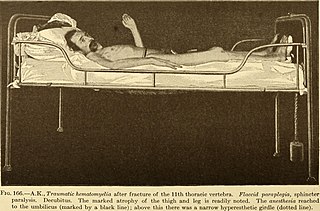
Paraplegia, or paraparesis, is an impairment in motor or sensory function of the lower extremities. The word comes from Ionic Greek (παραπληγίη) "half-stricken". It is usually caused by spinal cord injury or a congenital condition that affects the neural (brain) elements of the spinal canal. The area of the spinal canal that is affected in paraplegia is either the thoracic, lumbar, or sacral regions. If four limbs are affected by paralysis, tetraplegia or quadriplegia is the correct term. If only one limb is affected, the correct term is monoplegia. Spastic paraplegia is a form of paraplegia defined by spasticity of the affected muscles, rather than flaccid paralysis.
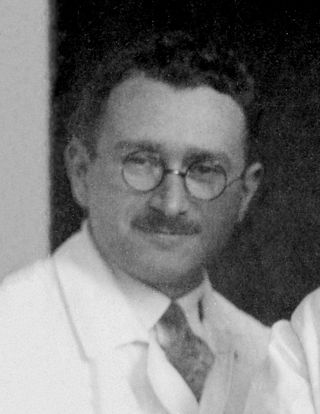
Sir Ludwig Guttmann was a German-British neurologist who established the Stoke Mandeville Games, the sporting event for people with disabilities (PWD) that evolved in England into the Paralympic Games. A Jewish doctor who fled Nazi Germany just before the start of the Second World War, Guttmann was a founding father of organized physical activities for people with disabilities.

A spinal cord injury (SCI) is damage to the spinal cord that causes temporary or permanent changes in its function. Symptoms may include loss of muscle function, sensation, or autonomic function in the parts of the body served by the spinal cord below the level of the injury. Injury can occur at any level of the spinal cord and can be complete, with a total loss of sensation and muscle function at lower sacral segments, or incomplete, meaning some nervous signals are able to travel past the injured area of the cord up to the Sacral S4-5 spinal cord segments. Depending on the location and severity of damage, the symptoms vary, from numbness to paralysis, including bowel or bladder incontinence. Long term outcomes also range widely, from full recovery to permanent tetraplegia or paraplegia. Complications can include muscle atrophy, loss of voluntary motor control, spasticity, pressure sores, infections, and breathing problems.
Kookal Ramunni Krishnan born in Kerala, was an Indian physician. He was the former director of Southport Regional Spinal Injuries Centre in Southport, United Kingdom, a lecturer in the department of neurological science at University of Liverpool, and visiting professor of rehabilitation at the University of Salford. He is credited with pioneering the spinal injuries service at Southport.
Spinal Cord Injuries Australia (SCIA) is a non-government organisation which provides advocacy and services to people with spinal cord injury and similar conditions.

Miguel Sarrias Domingo was Medical Director of the Institut Guttmann in Barcelona, Catalonia, Spain.
Ernest Herman Joseph Bors, MD was a Czech-born American physician. He was a pioneer in the multidisciplinary care of individuals with spinal cord injury (SCI).
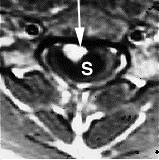
Myelomalacia is a pathological term referring to the softening of the spinal cord. Possible causes of myelomalacia include cervical myelopathy, hemorrhagic infarction, or acute injury, such as that caused by intervertebral disc extrusion.
Kristjan T. Ragnarsson is an American physiatrist who focuses on the rehabilitation of individuals with disorders of the central nervous system. He is the Dr. Lucy G. Moses Professor and Chair of Rehabilitation Medicine at The Mount Sinai Medical Center in New York City.
Sir George Montario Bedbrook, OBE was an Australian medical doctor and surgeon, who was the driving force in creating the Australian Paralympic movement and the Commonwealth Paraplegic Games, and helped to found the FESPIC Games.
S3, SB2, SM3 are disability swimming classifications used for categorising swimmers based on their level of disability. People in this class have decent arm and hand function, but no use of their trunk and legs. They have severe disabilities in all their limbs. Swimmers in this class have a variety of different disabilities including quadriplegia from spinal cord injury, severe cerebral palsy and multiple amputations.
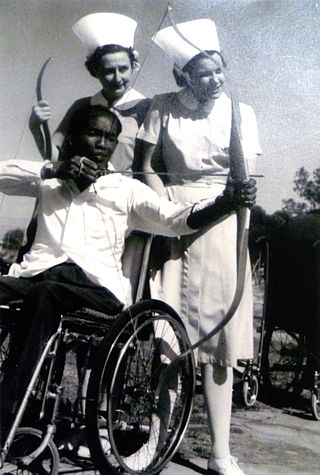
Janet Tyler OAM is an Australian Registered Nurse who was a member of the medical team selected to care for Australian athletes at the 1968 Summer Paralympics, Israel. She specialised in spinal nursing and rehabilitation at the Royal Adelaide Hospital and the Hampstead Rehabilitation Centre annex of Royal Adelaide Hospital, throughout the forty three years of her nursing career. Tyler was Senior Registered Nurse from 1964 to 1977, Clinical Nurse Coordinator from 1977 to 1986, Acting Nurse Manager at the Hampstead Centre from 1986 to 1994, Life Member of the Registered Nurse Association since 1951, Life Member of the Paraplegic and Quadriplegic Association of South Australia since 1977 and Justice of the Peace for over 30 years.

Although spinal cord injury (SCI) often causes sexual dysfunction, many people with SCI are able to have satisfying sex lives. Physical limitations acquired from SCI affect sexual function and sexuality in broader areas, which in turn has important effects on quality of life. Damage to the spinal cord impairs its ability to transmit messages between the brain and parts of the body below the level of the lesion. This results in lost or reduced sensation and muscle motion, and affects orgasm, erection, ejaculation, and vaginal lubrication. More indirect causes of sexual dysfunction include pain, weakness, and side effects of medications. Psycho-social causes include depression and altered self-image. Many people with SCI have satisfying sex lives, and many experience sexual arousal and orgasm. People with SCI may employ a variety of adaptations to help carry on their sex lives healthily, by focusing on different areas of the body and types of sexual acts. Neural plasticity may account for increases in sensitivity in parts of the body that have not lost sensation, so people often find newly sensitive erotic areas of the skin in erogenous zones or near borders between areas of preserved and lost sensation.
The American Spinal Injury Association (ASIA), formed in 1973, publishes the International Standards for Neurological Classification of Spinal Cord Injury (ISNCSCI), which is a neurological exam widely used to document sensory and motor impairments following spinal cord injury (SCI). The ASIA assessment is the gold standard for assessing SCI. ASIA is one of the affiliated societies of the International Spinal Cord Society.

The Wings for Life World Run is a running competition held on the first weekend of May since 2014 to collect funds for the not-for-profit foundation Wings for Life. The entry fee goes completely to Spinal Cord Research. It became the largest running event in 2021 with 184,236 runners participating in one single event. In 2023, the Wings for Life World Run celebrated its 10th anniversary with a record-breaking 206,728 participants.
F1, also T1 and SP1, is a wheelchair sport classification that corresponds to the neurological level C6. Historically, it was known as 1A Complete. People in this class have no sitting balance, and are tetraplegics. They may be able to perform limited actions with one hand. They lack sitting balance, and have limited head control and respiratory endurance. The process for classification into this class has a medical and functional classification process. This process is often sport specific.
F6, also SP6, is a wheelchair sport classification that corresponds to the neurological level L2 - L5. Historically, this class has been known as Lower 4, Upper 5. People in this class have good sitting balance, and good forward and backward movement of their trunk. They have some use of their thighs and can press their knees together.
Wheelchair sport classification is a system designed to allow fair competition between people of different disabilities, and minimize the impact of a person's specific disability on the outcome of a competition. Wheelchair sports is associated with spinal cord injuries, and includes a number of different types of disabilities including paraplegia, quadriplegia, muscular dystrophy, post-polio syndrome and spina bifida. The disability must meet minimal body function impairment requirements. Wheelchair sport and sport for people with spinal cord injuries is often based on the location of lesions on the spinal cord and their association with physical disability and functionality.
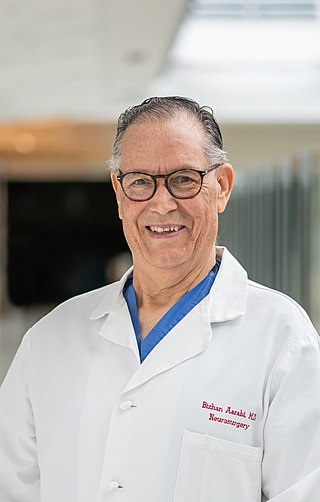
Bizhan Aarabi is an Iranian-American neurosurgeon, researcher, author, and academic. He is a professor of neurosurgery at University of Maryland and the Director of Neurotrauma at the R Adams Cowley Shock Trauma Center.








